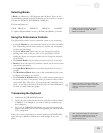
First Session
2
15
Selecting Banks
A Bank is a collection of 128 Programs and 100 Mixes. There are five
internal Banks available in the QS, and more can be accessed if you put a
card into the [PCMCIA EXPANSION CARD] slot.
The internal Banks are:
USER PRESET1 PRESET2 PRESET3 GenMIDI
To explore different Banks, use the [< BANK] and [BANK >] buttons.
Using the Performance Controls
The QS provides various ways to control the sound as you are playing:
• Keyboard Velocity lets you control the sound by how hard you hit the
keys. Depending on how hard you play, the volume and tonal quality
of the sound will change.
• Keyboard Aftertouch (QS6.2 only) lets you change the sound by
pressing down hard on the keys after you’ve played them. While
holding key down, you can press harder on it to change the character
of the sound.
• The Sustain Pedal is used to hold notes after you let go of the keys.
• Pedal 1 is most often used to control the volume, but it can be used to
control other parameters.
• The Pitch Bend Wheel allows you to alter the pitch of the notes as
you play.
• The Modulation Wheel allows you to add a modulation effect (such
as vibrato or tremolo) to the sound.
• The Controller A-D Sliders allow you to affect various parameters of
the sound. In most of the presets, slider [A] controls a filter or filter-
sweep effect, [B] a delay effect, [C] an envelope time, and [D] a reverb
effect. As you move the sliders, the LCD gives you visual feedback in
the form of small vertical bar graphs.
Transposing the Keyboard
1) Hold down the [TRANSPOSE] button.
2) Tap the key that represents the interval you’d like to shift by relative
to Middle C. For example, if you want to shift up a semitone, tap
the C-sharp key.
3) Let go of the [TRANSPOSE] button. An up or down arrow will
appear in the [TRN] area of the LCD depending on which direction
you’ve transposed.
When you want to return things to normal, hold down [TRANSPOSE]
again and tap on Middle C (marked by a small triangle on the front
panel).
NOTE: If you don’t see a bar graph in the
display when you move a slider, it means the
slider has no function in that particular
Program.
TIP: Using this method, you can tr
anspose
up or down by as much as one octave. To
transpose by a greater interval, use the
Global transpose page.
NOTE: You can overwrite the Programs
and Mixes in the User Bank. The other
Banks are permanent.


















